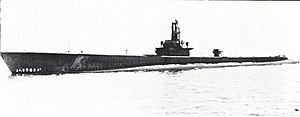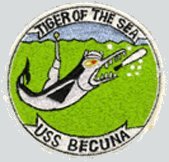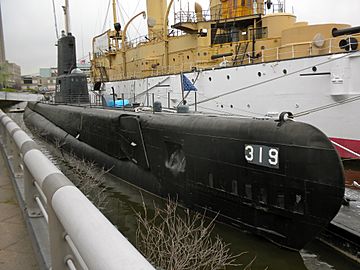USS Becuna facts for kids
 |
|
| History | |
|---|---|
| Namesake | Becuna |
| Ordered | 10 April 1942 |
| Builder | Electric Boat Company, Groton, Connecticut |
| Laid down | 29 April 1943 |
| Launched | 30 January 1944 |
| Sponsored by | Mrs. George C. Crawford, wife of Commander Crawford |
| Commissioned | 27 May 1944 |
| Decommissioned | 7 November 1969 |
| Stricken | 15 August 1973 |
| Motto | Tiger of the Sea |
| Honors and awards |
4 Battle Stars |
| Status | Museum ship at Philadelphia, 21 June 1976 |
| Badge |  |
| General characteristics As built | |
| Class and type | Balao-class diesel-electric submarine |
| Displacement |
|
| Length | 311 ft 9 in (95.02 m) |
| Beam | 27 ft 3 in (8.31 m) |
| Draft | 16 ft 10 in (5.13 m) maximum |
| Propulsion |
|
| Speed |
|
| Range | 11,000 nautical miles (20,000 km) surfaced at 10 knots (19 km/h) |
| Endurance |
|
| Test depth | 400 ft (120 m) |
| Complement | 10 officers, 72 enlisted |
| Armament |
|
| General characteristics Guppy IA | |
| Class and type | none |
| Displacement |
|
| Length | 307 ft 7 in (93.75 m) |
| Beam | 27 ft 4 in (8.33 m) |
| Draft | 17 ft (5.2 m) |
| Propulsion |
|
| Speed |
|
| Range | 17,000 nmi (31,000 km; 20,000 mi) surfaced at 11 knots (20 km/h; 13 mph) |
| Endurance | 36 hours at 3 knots (5.6 km/h; 3.5 mph) submerged |
| Complement |
|
| Armament |
|
|
USS Becuna (SS-319)
|
|
| Lua error in Module:Location_map at line 420: attempt to index field 'wikibase' (a nil value). | |
| Location | Penn's Landing, Delaware Ave. & Spruce St., Philadelphia, Pennsylvania, United States |
| Area | less than one acre |
| Built | 1944 |
| Built by | Electric Boat Co. |
| Architectural style | Balao-class submarine |
| NRHP reference No. | 78002458 |
| Added to NRHP | 29 August 1978 |
USS Becuna (SS/AGSS-319), a Balao-class submarine, is a former ship of the United States Navy named for the becuna, a pike-like fish of Europe. She was designated a National Historic Landmark for her service in World War II, for which she earned four battle stars. She presently serves as a museum ship at the Independence Seaport Museum in Philadelphia, Pennsylvania.
World War II
Becuna (SS-319) was launched 30 January 1944 by Electric Boat Company, Groton, Connecticut; sponsored by Mrs. George C. Crawford, and commissioned on 27 May 1944.
Becuna departed New London 1 July 1944 and arrived at Pearl Harbor 29 July. Her war operations extended from 23 August 1944 to 27 July 1945. During this period she completed five war patrols in the Philippines, South China Sea, and the Java Sea. Becuna is credited with having sunk two Japanese tankers totaling 3,888 tons.
The submarine arrived at Subic Bay, Luzon, from her last war patrol 27 July 1945. In September 1945 she arrived at San Diego.
Becuna received four battle stars for her World War II service.
Post-war service
After World War II Becuna continued to operate with Submarine Force, Pacific Fleet, until April 1949 when she was ordered to Submarine Force, Atlantic Fleet, as a unit of Submarine Squadron 8.
Between May 1949 and May 1950 she conducted refresher training exercises and also assisted in training of student officers and men at New London, Connecticut. In November 1950 she returned to Electric Boat Co., for a complete modernization overhaul, being refitted as a GUPPY-type submarine. The overhaul was completed in August 1951, and Becuna sailed to the Caribbean for shakedown. She returned to New London in September 1951.
Becuna operated with the Atlantic Fleet, making two cruises with the 6th Fleet in the Mediterranean and one to Scotland. Other than these extended cruises, the majority of Becuna's service was at New London as a training submarine.
In 1969, she was reclassified an Auxiliary Submarine, AGSS-319.
Museum ship
Becuna was decommissioned on 7 November 1969, and laid up in the Atlantic Reserve Fleet. She reverted to SS-319 in 1971. She was stricken from the Naval Register on 15 August 1973.
Becuna was placed on permanent display adjacent to the cruiser USS Olympia (C-6) at Penn's Landing in Philadelphia on 21 June 1976. Since 1996 both vessels have been operated by the Independence Seaport Museum.
She was designated a National Historic Landmark in 1986. In 2001, Becuna received the Historical Welded Structure Award of the American Welding Society.


